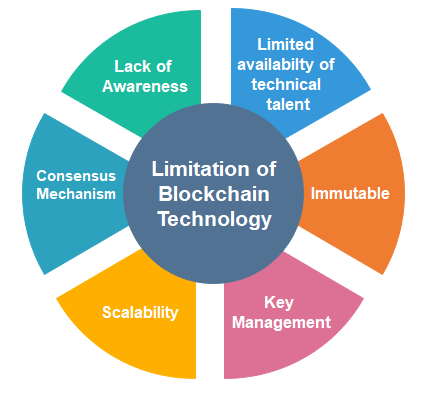Table of Contents
Blockchain technology has enormous potential in creating trustless, decentralized applications. But it is not perfect. There are certain barriers which make the blockchain technology not the right choice and unusable for mainstream application. We can see the limitations of blockchain technology in the following image.

1. Lack of Awareness
There is a lot of discussion about blockchain, but people do not know the true value of blockchain and how they could implement it in different situations.
2. Limited availability of technical talent
Today, there are a lot of developers available who can do a lot of different things in every field. But in the blockchain technology, there are not so many developers available who have specialized expertise in blockchain technology. Hence, the lack of developers is a hindrance to developing anything on the blockchain.
3. Immutable
In immutable, we cannot make any modifications to any of the records. It is very helpful if you want to keep the integrity of a record and make sure that nobody ever tampers with it. But immutability also has a drawback.
We can understand this, in the case, when you want to make any revisions, or want to go back and make any reversals. For example, you have processed payment and need to go back and make an amendment to change that payment.
4. Key Management
As we know, blockchain is built on cryptography, which implies that there are different keys, such as public keys and private keys. When you are dealing with a private key, then you are also running the risk that somebody may lose access to your private key. It happens a lot in the early days when bitcoin wasn’t worth that much. People would just collect a lot of bitcoin, and then suddenly forgot what the key was, and those may be worth millions of dollars today.
5. Scalability
Blockchain like bitcoin has consensus mechanisms which require every participating node to verify the transaction. It limits the number of transactions a blockchain network can process. So bitcoin was not developed to do the large scale volumes of transactions that many of the other institutions are doing. Currently, bitcoin can process a maximum of seven transactions per second.
6. Consensus Mechanism
In the blockchain, we know that a block can be created in every 10 minutes. It is because every transaction made must ensure that every block in the blockchain network must reach a common consensus. Depending on the network size and the number of blocks or nodes involved in a blockchain, the back-and-forth communications involved to attain a consensus can consume a considerable amount of time and resources.

